1. a large number of independent buyers and sellers.
2. standardized goods.
3. prices that are "discovered" through the interaction of buyers and sellers. No individual can dictate the market price.
|
|
?
|
|
|
|
?
|
|
Market demand is the horizontal summation of the individual demand curves. Or, instead of just my individual demand for a product what if there were two people, or more, in the market. the result would be tat for each price, the quantities demanded would be greater since there are more people. The prices stay the same, but the quantities get larger, or the demand graph shifts horizontally (to the left).
Given the following individuals' demand schedules for product X, and assuming these are the only three consumers of X, which set of prices and output levels below will be on the market demand curve for this product?
A.
($5, 2); ($1, 10)
B.
($5, 3); ($1, 18)
C.
($4, 6); ($2, 12)
ANSWER
D.
($4, 0); ($1, 3)
Economists stress the importance of price in determining how much people will buy. That is why they put price on the demand graph, but there are other things that affect how much of a product we buy besides the price. When we developed my demand curve for pizza we employed the ceteris paribus assumption. I didn't get a large increase in my income. I didn't win the lottery. There wasn't a new study out that stated pizzas cause cancer. All other factors remained the same - only the price and quantity demanded changed.
But there are other determinants of how much we demand (or buy) besides the price. We call these the Non-Price determinants of Demand.
Let's not talk about pizzas anymore and use a new product in our examples. - - - How about vodka? We know that when the price of vodka goes up we buy less and when the price goes down we buy more (this is the law of demand). But what else might cause us to buy more vodka besides the price? In other words, IF THE PRICE OF VODKA STAYED THE SAME, what might cause us to buy more or less vodka?
Economists classify the non-price determinants of demand into 5 groups:
expected price (Pe)
price of other goods (Pog)
income (I or Y) (In Macroeconomics "I" usually stands for "investment" and "Y" stands for "income".)
number of POTENTIAL consumers (Npot), and
tastes and preferences (T).
Let's briefly look at each one here and in more detail later.
Pe - If we hear that there will be a new $5 tax on a bottle of vodka beginning next week, what happens to the amount of vodka sold this week at the current price? It probably increases since some people will buy more now to avoid the higher future prices.
Pog - What happens to the amount of vodka sold if the price of gin increases? Might not some people who were going to buy gin buy vodka instead since the price of gin went up? Or what might happen to vodka sales if the price of tomato juice goes down? maybe now with the cheaper tomato juice prices some people might want to drink more bloody marys (vodka mixed with tomato juice)? If so, vodka sales would go up.
Y (or I) - If I get a raise and my income increases I might buy more vodka - or if my income goes down I would probably buy less vodka. (And if I lost my job I might buy a lot of vodka :-)
Npot - What would happen to vodka sales if they lowered the drinking age. This would increase the number of potential vodka consumers and they would probably sell more vodka.
Finally T - Tastes and preferences really means "everything else". There are hundreds of factors that affect the quantity of vodka sold. We don't want to memorize hundreds of different determinants for each product, so economists group everything else into "tastes and preferences". Anything that might make consumers want more or less vodka will change the quantity sold. For example, if a new study says that drinking vodka causes blindness - people will buy less. Right before a holiday people may buy more.
In order to remember these determinants of demand, think of somebody who has had too much vodka to drink and they come staggering into a liquor store demanding, "G-g-give m-me an-n-n-nother p-p-p-pint of v-v-vodka".
Get it? "p-p-p-pint " or P, P, P, I, N, T or Px, Pe, Pog, I, Npot, T
In order to save me time in typing, I will type "P, P, I, N, T" instead of "the non-price determinants of demand".
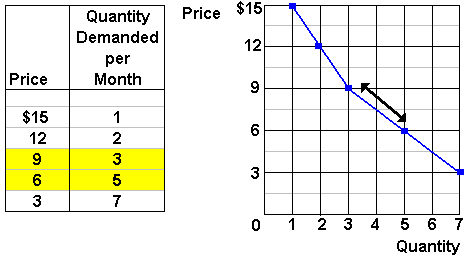
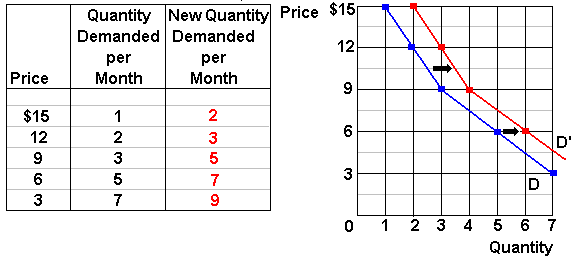

Pe in the future

D today
Pe in the future

D today
If you expect the price to go up in the future demand today will increase (shift to the right). For example, if we read that there will be a new tax on vodka starting next week, people will want to buy more now before the price increases. Retailers understand this. How often have you heard "SALE ENDS MONDAY"? They want you to expect the price to increase in the future so you'll buy it today.
The opposite happens when you expect the price to go down in the future. In the past when my wife and I were shopping whenever I put something in the cart, she would take it out and put it back on the shelf! I'd ask, "why are you doing that?". She would say that she expected it to go on sale soon and we should wait until it does. If you expect the price to go down in the future demand today decreases. (f ¯Pe in the future Þ ¯D today). But, whenever I put something in the cart, she would take it out saying that she expects it to go on sale soon. After awhile I got a little upset, when I'd ask her about the items she put in the cart and she'd say that they were on sale last week and we missed it. Finally, I went to talk to the store manager and explained the situation to him. He saved our marriage by explaining that most chain store have a policy stating that if an item goes on sale after you have purchased it, you can bring in the receipt within 30 days and get a refund. Retailers understand how price expectations affect demand.
The effect of a change in the price of other goods on demand depends on what type of other goods we are talking about. There are three types:
1) substitute goods
Substitute goods are goods where if you buy more of one, you buy less of the other one. Examples of substitutes include vodka and gin, hot dogs and hamburgers, chicken and beef, Coca-Cola and Pepsi.
Let's look at Coke and Pepsi. If the price of Coke increases it will increase the demand for Pepsi (the graph shifts to the right).I f you are going to buy a can of Coke, you may walk right past the Pepsi machine, but when you notice that the price of Coke has increased, you'll probably turn around and buy the Pepsi. You weren't going to buy Pepsi before, but now, at the same price, you are willing to buy it. So the demand for Pepsi has increased. The demand curve has shifted to the right. At the same prices, the quantities demanded are greater.
If the price of Coke increases, what happens to the demand for Coke? - - - NOTHING. Price does not change demand (as we have defined it) but it will change the quantity demanded.
You've seen a good example of this in your local grocery store. For example, I may want to buy some coffee. So I go to the coffee aisle and grab a can of Folgers and continue down the aisle. But at the end of the aisle I see a display of Maxwell House coffee on sale! What do I do with the Folgers in my shopping cart? - - - - - No, I don't put it back. I take it out of my cart and put it on the Maxwell House display. Haven't you seen various brands mixed in with such displays? The demand for Folgers decreased (I no longer want it at that price, so I take it out of my cart) because the price of Maxwell House decreased.
If:
P Maxwell House coffee

D Folgers coffee
2) complementary goods
Complementary goods are goods where if you buy more of one you also buy more of the other one. they go together like vodka and tomato juice, rum and Coke, film and film developing, hot dogs and hot dog buns.
Let's say that you want to eat hot dogs tonight and you go to your local grocery store and put a bag of buns in your cart and head down the aisle to the wieners. When you get to the wiener display you notice that their price has increased significantly so you decide not to eat hot dogs. What are you going to do with the buns? You should put them back, but if you are like many people you'll put them in the wiener display and move on quickly. But the point is, you were going to buy the buns at their present price (they were already in your cart), but when you learned the price of hot dogs increased your demand for buns decreased (the demand curve shifted to the left - at the same prices the quantities demanded decreased).
P of wieners

D of buns
Of course, if the price of one product decreases (cheaper film developing), the demand for its complement (film) increases.
P of one product

D of its compliment
3) independent goods
Independent goods are goods where if the price of one changes, it has no effect on the demand for to other one. For example, what happens to the demand for paper clips if the price of surfboards increases? Nothing.
Summary (Pog):
P of one product

D of its substitute
P of one product

D of its substitute
P of one product

D of its compliment
P of one product

D of its compliment
1) normal goods
For most goods, called normal goods, if consumer incomes increase, demand will increase and vice versa.
Income

D for normal goods
Income

D for normal goods
So if incomes increase, the demand curve for restaurant meals, and cars, and boats, will shift to the right. At the same prices people will buy more.
2) inferior goods
For some goods, called inferior goods, if consumer incomes increase demand will decrease, and vice versa. If only you had more money, you would buy less of that product
Income

D for inferior goods
Income

D for inferior goods
The term "inferior good" does not mean they are of low quality. the definition of an inferior good is one where if your income increases, demand decreases. There is an inverse relationship between income and demand.
Examples of inferior goods might include used clothing, potatoes, rice, maybe generic foods. If you lose your job (so your income decreases) you may shop for clothes at the Salvation Army Thrift Store (demand for used clothing increases).
What is a normal good for one consumer might be an inferior good for another. For example, if the income of one family increases they may buy a second small car (a normal good), but for another family, an increase in income may mean that they don't buy a small car (an inferior good) anymore and they buy a mini van instead.
An increase in the number of potential consumers will increase demand and vice versa.
Npot

D
Npot

D
Earlier we say that if they lowered the drinking age, the demand for vodka would increase.
Often economists say that an increase in the "number of consumers" will increase demand. I prefer to use the terminology "number of POTENTIAL consumers" because if K-Mart has a sale on Pepsi (price of Pepsi decreases) what happens to demand for Pepsi? -- Nothing (price does not change the demand schedule). But, if K-Mart has a sale on Pepsi (price of Pepsi decreases) what happens to the number of consumers buying Pepsi? It will increase. (The law of demand says that if price goes down, quantity demanded goes up.) So, if they have more customers because the price went down, what happens to demand? Nothing - (price does not change the demand schedule).
But, if the number of POTENTIAL customers changes, demand will change.
Four circumstances can change the number of potential consumers:
population change
If a new housing development is built in the empty field behind a small store, the number of potential consumers increases, and demand will increase.
expanded marketing area
Coors beer used to sold only out West. President Ford used to have to have it flown in to the While House because you couldn't buy it anyplace else. Then when Coors expanded to all states, demand increased because now there are more potential consumers.
new competitor (changes the demand curve facing and individual store, but NOT market demand curve)
If a new liquor store moves in across the street from and existing store, the demand for liquor of the existing store will decrease since now there are fewer potential consumers since some of the consumers walking past the store will have already bought something at the new store.
change in eligible consumers (i.e. drinking age)
If they lower the drinking age there will be more potential vodka drinkers so demand for vodka will increase.
There are hundreds of factors that affect the quantity of vodka sold. We don't want to memorize hundreds of different determinants for each product, so economists group everything else into "tastes and preferences". Tastes and preferences really refers to "everything else". Anything that increases a consumer's preference for a product will increase demand for that product. This will include advertising and fads.

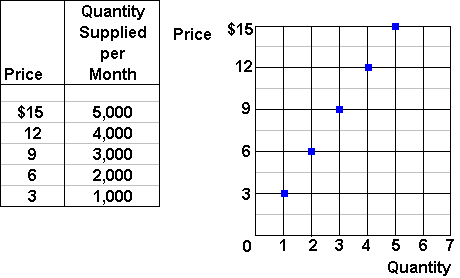
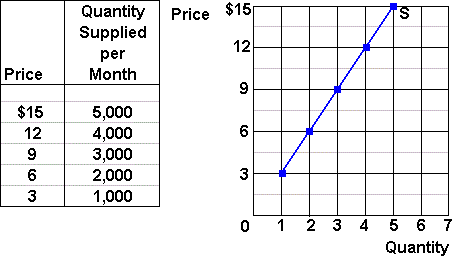
Economists stress the importance of price in determining how much will be produced. That is why they put price on the supply graph, but there are other things that affect how much of a product will be produced besides the price. When we developed the supply curve for pizza we employed the ceteris paribus assumption. we assumed all other things stayed constant. For example there were no new technological discoveries, the prices of resources stayed the same, or no change in taxes. All other factors remained the same - only the price and quantity supplied changed.
But there are other determinants of how much business supply besides the price. We call these the Non-Price determinants of Supply.
Economists classify the non-price determinants of supply into 6 groups:
a. Pe -- expected price
b. Pog -- price of other goods ALSO PRODUCED BY THE FIRM
c. Pres -- price of resources
d. T --technology
e. T --taxes and subsidies
f. N -- number of producers/sellers
|
|
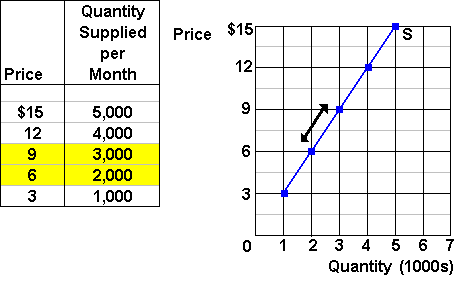
If there is an increase in supply (
S) the supply curve moves to the RIGHT. At the same prices, the quantities supplied will be greater
If there is an decrease in supply (
S) the supply curve moves to the LEFT. At the same prices, the quantities supplied will be smaller.
Pe -- change in expected price
Pog -- change in price of other goods ALSO PRODUCED BY THE FIRM
Pres -- change in price of resources
Tech -- change in technology
Tax -- change in taxes and subsidies
Nprod -- change in number of producers/sellers
If a business expects that they can get a higher price in the future, what will happen to supply today? They will be less willing to sell there products today because they will know that if they waited they could get a higher price so supply today would decrease, shift to the left. (Remember, supply is not the quantity available for sale.)
Let's say that you want to sell you car, somebody offers you $1500 today, and you accept it. You are willing to sell your car for $1500 today. THEN, somebody says that they will dive you $2000 for your car if you could wait three days. Now you expect that you can get a higher price ($2000) in the future, so you will probably no longer want to sell your car for $1500 today.
Pe

S today
Pe

S today
First, think of a business that produces two products, like farmers who can either grow corn or soybeans. Then the price of one increases, what happens to the supply of the other one.
So if the price of soybeans increases, what happens to the supply of corn?
If the price of soybeans increases the supply of corn will decrease. The supply curve of corn will shift to the left as farmers plant more soybeans and less corn.
P soybeans

S corn
P soybeans

S corn
If the price of soybeans increases, what happens to the supply of soybeans?
-
-
-
Nothing. Remember, price does not change supply, it changes the quantity supplied. so if the price of soybeans increases, we would get an increase in the quantity supplied (same supply curve, higher quantity).
costs

S (shifts left)
costs

S (shifts right)
If the price of a resource used to produce the product increases, this will increase the costs of production and the producer will no longer be willing to offer the same quantity at the same price. They will want a higher price to cover the higher costs. This shifts the supply curve to the left (
S).
For Example: if the autoworkers unions receives a significant wage increase, this will increase the costs of producing cars and decrease the supply of cars (
S).
P autoworkers wages

costs of producing cars

S cars
Pres

costs

S
Pres

costs
S
Does improved technology increase or decrease the costs of producing a product?
Improved technology DECREASES costs and therefore increases supply. If the technology did not decrease costs, then it wouldn't be used. If there is a high-tech expensive way to produce a product and a low-cost, low-tech, way to produce the same product, companies that use the low-cost methods will be able to sell the product at a lower price and beat out the high-cost producers.
Improved technology

costs

S
What has improved technology done to the costs of medical care? Improved medical technology has INCREASED the cost of medical care BUT it has also changed the outcome. For example let's say that there is a disease where with existing low-cost technology, half the patients die. Now, if they invent a new high-cost technology that will save all lives which technology will be used? Of course the new high-cost technology will be used, BUT THE PRODUCT HAS CHANGED. One product is when half the patients die, the other product is when all patients live. We can't put two products on one supply curve.
Let's use one more medical example. Why do doctors still use low-tech stethoscopes? they were using similar stethoscopes a hundred years ago. Isn't here a high-tech electronic stethoscope? Yes there is, so why don't doctors use it? Because it is more expensive AND IT GIVES THE SAME RESULTS. Doctors will use the cheaper technology as long as the results are the same. but obstetricians do use the more expensive high-tech stethoscope because it gives them better results. The low-tech stethoscopes can't always pick out the fetal heart beat. the newer high-tech and higher-cost electronic stethoscopes can. The product changes.
So, improved technology will decrease costs and increase supply OR it will increase costs and change the product which we cannot put on one graph.
Here we will discuss excise taxes. Excise taxes are a "per-unit" tax imposed on the production or sale of a product. Examples include the gasoline tax (so much per gallon), the cigarette tax (so much per pack) and the liquor tax (so much per bottle).
Let's discuss the gasoline tax. If the tax on gasoline increases will this affect the demand for gasoline or the supply of gasoline? If you said demand - then which non-price determinant of demand has changed? remember price does not change demand.
If the tax on gasoline increases, this will raise the cost of SELLING gasoline, and DECREASE SUPPLY.
Taxes

costs

S
Taxes

costs

S
Who pays the gasoline tax? Who pays the wages of the gas station employees? Whether you answer the consumer of the gas station owner, you have to give the same answer for both questions. Both taxes and wages are costs to the producer or seller. Higher gasoline taxes do not shift the demand curve, but they may result in a higher price and therefore a decrease in quantity demanded.
Subsidies are the opposite of taxes. Instead of the business paying the government, the government pays the business. There are fewer subsidies than taxes. But let's say the the government wants to encourage the use of solar energy so they put a subsidy (or increase one) on solar energy equipment. this will decrease the costs of producing or selling the equipment because when they produce or sell one they get a refund (subsidy) from the government.
Subsidies

costs

S
Subsidies

costs

S
An increase in the number of producers of a product will increase supply of that product. If the number of computer manufacturers increases, the supply of computers will increase (shift to the right).
Nprod

S
Nprod

S
"In a capitalist society prices are determined by the interaction of demand and supply. Since prices are so important, we need to better understand how they are determined. why is the price of gasoline $1.59 a gallon. Why does a candy bar cost $0.75? Why is the price of plywood normally $10 a sheet, but $30 a sheet after a hurricane?"
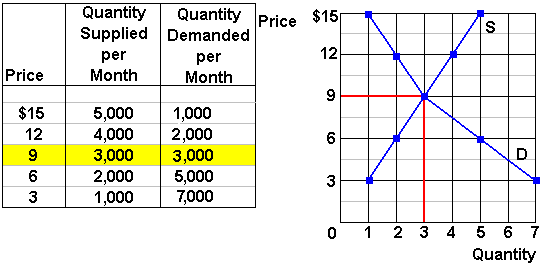
DEMAND:
Pe,
Pog,
I,
Npot,
T
SUPPLY:Pe,
Pog,
Pres,
Tech,
Tax,
Nprod
|
|
|
Demand increases:
|
|
|
|
Demand decreases:
|
|
|
|
Supply increases:
|
|
|
|
Supply decreases:
|
DON'T LOOK!!!
Graph it right now and determine what would happen to price and quantity if supply increases and demand decreases.
In a face-to-face class I would have my students do this themselves and tell me what happens to P and Q. So let's do it in this distance learning class.
-
-
-
-
What do you get? What happens to price and quantity if supply increases (shifts to the right) and demand decreases (shifts to the left)?
-
-
If supply increases and demand decreases:
- price decreases
- quantity is Indeterminate
The price will decrease, but we cannot tell what happens to quantity. Quantity could increase, it could decrease or it could stay the same. What happens to quantity depends on how much the supply and demand curves shift and since we were not told this, we cannot determine what happens to quantity. Quantity is indeterminate.
See the graph below where we can see that if demand decreases a little (D2) then the equilibrium quantity will increase, but if the demand curve decreases a lot (D4) the equilibrium quantity will decrease.
What happens to price and quantity if supply decrease and demand increases?
GRAPH IT!
-
-
-
-
If supply decreases and demand increases:
- price increases
- quantity is indeterminate
The price will increase, but we cannot tell what happens to quantity. Quantity could increase, it could decrease or it could stay the same. What happens to quantity depends on how much the supply and demand curves shift and since we were not told this, we cannot determine what happens to quantity. Quantity is indeterminate. Try graphing different shifts in D and S and see what happens to quantity.
What happens to price and quantity if both supply and demand increase (shift to the right)?
GRAPH IT before scrolling (or looking) lower on this page.
-
-
-
-
If supply increases and demand increases:
- quantity increases
- price is Indeterminate
The quantity will increase, but we cannot tell what happens to price. The price could increase, it could decrease or it could stay the same. What happens to the price depends on how much the supply and demand curves shift and since we were not told this, we cannot determine what happens to price. Price is indeterminate.
See the graph below where we can see that if supply increases a little (S1) then the equilibrium price will increase, but if the supply curve increases a lot (S3) the equilibrium price will decrease.
What happens to price and quantity if supply decrease and demand increases?
GRAPH IT!
-
-
-
-
If supply decreases and demand decreases:
- quantity decreases
- price is indeterminate
The quantity will decrease, but we cannot tell what happens to price. price could increase, it could decrease, or it could stay the same. What happens to price depends on how much the supply and demand curves shift and since we were not told this, we cannot determine what happens to price. Price is indeterminate. Try graphing different shifts in D and S and see what happens to price.
(1) Which determinant has changed?
(2) Will it affect supply or demand?
(3) Will supply or demand increase or decrease?
(4) GRAPH IT! What happens to price and quantity?
|
|
(1) Which determinant has changed?
Sometimes this is obvious. In this example it is income.
(2) Will it affect supply or demand?
Income is a determinant of DEMAND. But at other times this is more difficult. For example Pe and Pog are determinants of BOTH demand and supply.
(3) Will supply or demand increase or decrease?
This is the key to using the tool correctly. We discussed above how the non-price determinants shift the curves. Computers are normal goods. This means that if incomes increase, demand for computers will increase.
(4) Finally, GRAPH IT! the graph will tell you what happens to price and quantity. See graph below.
|
|
|
|
|
(1) Which determinant has changed?
TECHNOLOGY
(2) Will it affect supply or demand?
SUPPLY
(3) Will supply or demand increase or decrease?
SUPPLY WILL INCREASE (shift to the right)
(4) GRAPH IT! What happens to price and quantity?
|
|
|
|
|
(1) Which determinant has changed?
Pog - the product on the graph is Nintendo Video Game Systems and the price of another product, computers, has changed
(2) Will it affect supply or demand?
The non-price determinant, Pog, is a determinant for both supply and demand. With supply we said it refers to the price of other good PRODUCED BY THE SAME FIRM. Does Nintendo also produce computers? NO.
With demand, Pog refers to the price of substitute and the price of complements. Are video game systems and home computers substitutes or compliments? Most people would say they are substitutes. If you buy a new home computer, you can play games on the computer and maybe you won't buy a new video game system.
So, if there is a decrease in the price of personal computers, DEMAND FOR VIDEO GAME SYSTEMS WILL CHANGE.
(3) Will supply or demand increase or decrease?
if there is a decrease in the price of personal computers, DEMAND FOR VIDEO GAME SYSTEMS WILL DECREASE (shift to the left).
(4) GRAPH IT! What happens to price and quantity?
|
|
|
(1) Which determinants have changed?
(2) Will they affect supply, demand, or both?
(3) Will supply or demand increase or decrease?
(4) GRAPH IT! Then show what happens to price and quantity?
Top PC makers cut prices
Compaq clears out old models; Dell passes on lower component costs
February 1, 2000: 2:44 p.m. ET
NEW YORK (CNNfn) - Two of the world's largest computer makers on Tuesday announced that they have cut prices on their commercial desktop PCs.
Compaq, the No. 1 PC maker, said it cut prices up to 13 percent on most of its Deskpro series commercial PCs. The price cuts are being made to clear the way for nine new Deskpro models. . . . . . . . . . . . . . . .Dell (DELL: Research, Estimates), the world's second largest supplier of PCs, said it was cutting prices because the cost of the components it uses to make them have also dropped.
Effective Monday, a Dell Precision WorkStation 210 with a Pentium III processor running at 650 million cycles per second will sell for $1,740, a 17.1 percent reduction, the company said. Dell also said it cut prices on the mid-range models in its Precision WorkStation 410 line by up to 15.5 percent.
(1) Which determinants have changed?
The article says "Dell (DELL: Research, Estimates), the world's second largest supplier of PCs, said it was cutting prices because the cost of the components it uses to make them have also dropped." This indicates the there has been a change in the price of resources (
Pres)
(2) Will they affect supply, demand, or both?
SUPPLY
(3) Will supply or demand increase or decrease?
SUPPLY WILL INCREASE (shift to the right)
(4) GRAPH IT! Then show what happens to price and quantity?
|
|
|
(1) Which determinants have changed?
(2) Will they affect supply, demand, or both?
(3) Will supply or demand increase or decrease?
(4) GRAPH IT! Then show what happens to price and quantity?
Air customers to pay for fuel
With demand for seats still strong, most carriers announce fuel surcharges
By Staff Writer Chris Isidore
January 21, 2000: 3:54 p.m. ET
NEW YORK (CNNfn) - Airlines are finding a source of relief for oil price shocks they've rarely tapped before: their passengers.
With oil prices hitting a post-Gulf War high Friday, three more carriers - US Airways, America West and Trans World Airlines - announced surcharges, charging customers $20 per round-trip ticket on virtually all domestic flights.
That meant that eight of the nine largest carriers in the country now had the charges, with only No. 7 Southwest Airlines (LUV), the Dallas-based discount carrier, holding off at this time.
Demand for seats opens door
The surcharge is unique in its acceptance by the typically cutthroat airline industry, and is a sign that demand for air travel remains strong.
The Air Transport Association report that 71.3 percent of its members' seats were filled last year, the best rate in the history of passenger jet travel.
With demand remaining strong despite the spike, airlines are in a better position to seek higher fares.
"In the past, when we had the tremendous run up in fuel, we also had a recession," said David Swierenga, the ATA's chief economist. "Those two things together clobbered the industry. Now the economy is moving ahead, and carriers will have a little more flexibility on the pricing side.". . . . . . . . .
(1) Which determinant has changed?
PRICE OF RESOURCES. Oil (fuel) is a resources used by the airline industry
(2) Will they affect supply or demand?
SUPPLY
(3) Will supply or demand increase or decrease?
SUPPLY WILL DECREASE (shift to the left)
(4) GRAPH IT! Then show what happens to price and quantity?
|
|
|
(1) Which determinant has changed?
INCOME ("The economy is moving ahead" means incomes are rising.)
(2) Will they affect supply or demand?
DEMAND
(3) Will supply or demand increase or decrease?
DEMAND WILL INCREASE (assuming air travel is a normal good)
(4) GRAPH IT! Then show what happens to price and quantity?
|
|
|
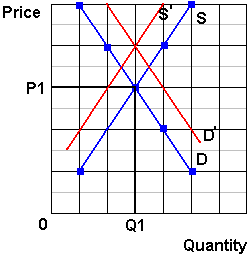
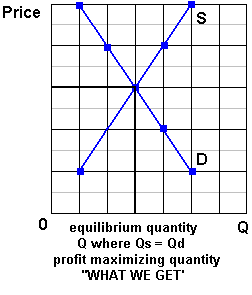
select all where: MB > MC
up to where: MB = MC
but never where: MB < MC
Marginal Social Benefits (MSB) are the additional benefits that society (or the consumer who is a part of society) receives when one more unit of a good or service is consumed.
MARGINAL SOCIAL COASTS are the additional costs to society (or to the producer who is a part of society) when one more unit of a good or service is produced.
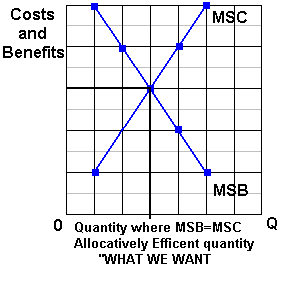
|
|
|
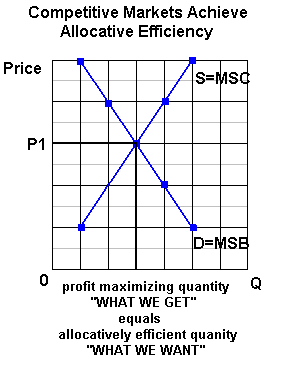
Market Demand = Marginal Social Benefits (D=MSB)
(and this is true if there are no positive externalities (spillover benefits))Market Supply = Marginal Social Costs (S=MSC)
(and this is true if there are no negative externalities (spillover costs))THEREFORE if there are no negative externalities (spillover costs) and no positive externalities (spillover benefits) competitive markets (capitalism) achieves allocative efficiency
WHAT WE GET = WHAT WE WANT
This is the "invisible hand" of capitalism.
|
In a market economy with no positive externalities (spillover benefits) and no negative externalities (spillover costs):
|
1. "Scalping" refers to the practice of reselling tickets at a higher-than-original price, which happens often with athletic and artistic events. Is this "ripping off" justified?
2. Ticket re-sales are voluntary-both buyer and seller must feel that they gain or they would not agree to the transaction.
3. "Scalping" market simply redistributes assets (tickets) from those who value them less than money to those who value them more than the money they're willing to pay.
4. Sponsors may be injured, but if that is the case, they should have priced the tickets higher.
5. Spectators are not damaged, according to economic theory, because those who want to go the most are getting the tickets.
6. Conclusion: Both seller and buyer benefit and event sponsors are the only ones who may lose, but that is due to their own error in pricing and they would have lost from this error whether or not the scalping took place.
1. Competitive markets generate productive efficiency - the production of any particular good in the least costly way. Sellers that don't achieve the least-cost combination of inputs will be unprofitable and have difficulty competing in the market.
2. The competitive process also generates allocative efficiency - producing the combination of goods and services most valued by society.
3. Allocative efficiency requires that there be productive efficiency. Productive efficiency can occur without allocative efficiency. Goods can be produced in the least costly method without being the most wanted by society.
4. Allocative and productive efficiency occur at the equilibrium price and quantity in a competitive market. Resources are neither over- nor underallocated based on society's wants.